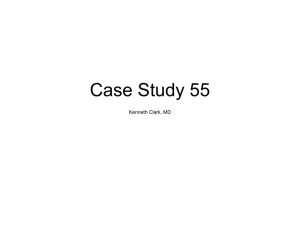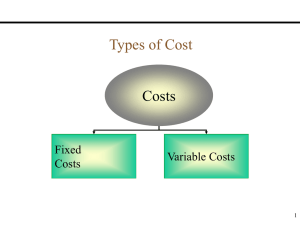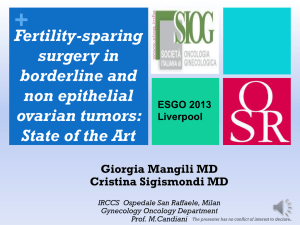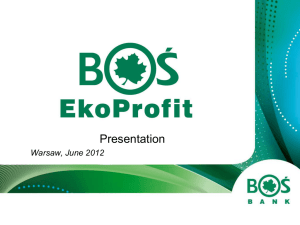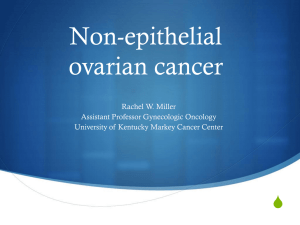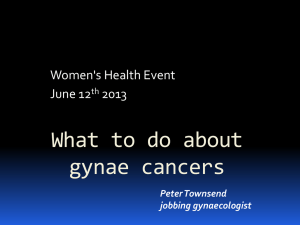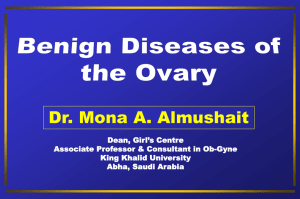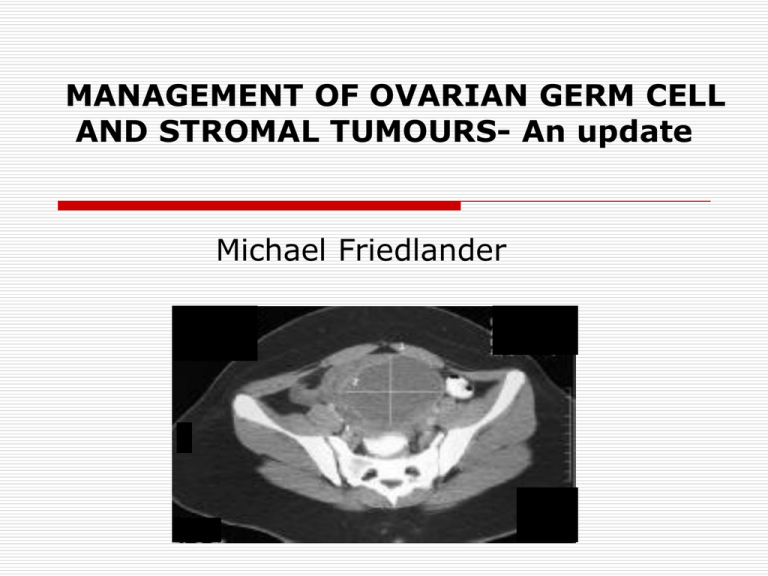
MANAGEMENT OF OVARIAN GERM CELL
AND STROMAL TUMOURS- An update
Michael Friedlander
Ovarian Germ Cell Tumours
1-2% of all ovarian malignancies
Usually in adolescents but 42% of 614
patients were over 30!
60-70% STAGE 1 at diagnosis
No randomized trials in OGCT
Guided by results of large body of data
from randomized trials in testis cancer
Ovarian Germ Cell Tumours
Dysgerminoma
Endodermal sinus tumour
Embryonal Carcinoma
Choriocarcinoma
Teratoma-Mature/Immature
Immature – low grade/high grade
Surgical Principles
Suspect diagnosis
Pre-operative markers
Conservative- fertility preserving surgery
Staging-controversial- careful inspection of
peritoneum, omentum, contralateral ovary
and nodes with washings and biopsies of
suspicious areas adequate
Unilateral oophorectomy with debulking if
advanced stage
Management Principles
Monitoring tumour markers
b hcg AFP LDH
t ½ b HCG 24- 48 hrs AFP 5-7 days
Switch to salvage therapy if markers not
falling adequately or rising during
treatment
Radiological re-staging following therapy
Resection of residual masses particularly if
teratoma elements in primary
IGCCCG Prognostic classification
Testis cancer
Prognosis
Proportion
survival
Non-seminoma
seminoma
Good
56%
90%
AFP<1000
& BHCG<1000
& LDH<1.5 N
Any marker
level
& no visceral
mets
Intermediate
28%
80%
AFP 1000-10,000
& BHCG 100010,000
& LDH 1.5-10 ULN
Non
pulmonary
mets
Poor
16%
50%
Non pulmonary
mets
AFP >10,000
BHCG>10,000
LDH> 10 ULN
Staging System-POG
Stage 1-limited to ovary. Washings –ve.
Markers fall within T ½
Stage 2-microscopic residual/positive
nodes<2cm.-ve washings
Stage 3->2cm nodes;gross
residual,contiguous visceral
involvement;+ve washings
Stage 4-distant metastases
Malignant Germ Cell Tumors in Children
and Adolescents-POG Study
J Paed.Surg 39;424:2004
Stage
1
2
3
4
No.
41
16
58
16
6yr EFS%
95
87.5
96.6
86.7
6yr S%
95.1
93.8
97.3
93.3
BEP B 15mg/m2 D1 E 100mg/m2 1-5 P 20/m2 1-5
4 cycles at 3 weekly intervals
Management of Dysgerminomas
Most patients Stage 1a- surveillance
appropriate.
15% will relapse and salvaged with
chemotherapy
Rare-therefore not clear if BEP X 3 is essentialin advanced or recurrent disease
GOG STUDY- 39 patients with stage 1b-3
completely resected-treated with Carboplatin
400mg/m2 and etoposide 120mg/m2 x3 every
4 weeks x 3 No recurrences
Management of Good Prognosis Subset
BEP x 3
If Bleomycin contraindicated or dropped- EP
X4
5 day BEP less toxic and optimal regimen
B 30 U d1,8,15
E 100mg/m2 1-5
Cisplatin 20mg/m21-5
Australian Germ Cell Study
Lancet 357;739;2001
Indiana BEP vs. 4 Cycles
Cisplatin 100mg/m2 day1
Etoposide 120mg/m2 d1-3
Bleomycin 30 u q21
166 randomized
Trial stopped as 1 vs. 9 deaths from cancer in
the 2 regimens
5 day BEP-Indiana superior regimen
Toxicity of BEP
Pulmonary toxicity 3%; decreased DLCO
20%
AML 0.2- 1%
Neuropathy 20%
Raynauds 20%
Tinnitus 24%
High tone hearing loss 70%
Gonadal dysfunction 16 -30%
Cardiovascular disease/Hypertension
How important is Bleomycin
Bleomycin should only be omitted if
contra-indications when 4 cycles of EP
can be used
Inconsistent findings from trials of 4
EP vs 3 BEP
Management of Intermediate to Poor
Risk Subgroup
BEP X 4- represents standard of care
Multiple studies using various combinations
and permutations do not appear superior
VeIP appropriate if compromised lung
function
High dose therapy not demonstrated to be
superior first line treatment
Accelerated BEP
Intermediate-high risknew Australian study
Administer every 14 days with
pegylated GCF support day 6
Cisplatin 20 mg/m2 day1-5
Etoposide 100mg/m2 d1-5
Bleomycin 30 u weekly x 12
Role of Second Look Surgery
Not necessary in patients with
completely resected disease at primary
surgery
Resection of residual masses-particularly
if teratomatous elements in primary
tumour
Resection of residual masses in nondysgerminoma – 50% necrosis;35%
mature teratoma; 15% residual cancer
Second look surgery
Matthew et al J Postgrad Med 2006
68 patients with germ cell tumors
35 residual mass post chemo
29 laparotomy
3 patients had viable tumor, 7 immature
teratoma, 3 mature teratoma and 16
necrosis or fibrosis
no cases of viable tumour if dysgerminoma,
embryonal carcinoma
/absence of teratoma in primary
Salvage therapy TIP
Journal of Clinical Oncology 18; 2000: 2413-2418
Treatment consisted of four cycles of TIP given
21 days apart.
Paclitaxel 250/m2 by 24-hour infusion on day
1, followed by an ifosfamide 1.2 g/m2 infusion
given over 4 hours, and cisplatin 20 mg/m2 on
days 2 through 6.
80% of 30 achieved a favorable response.
22 (73%) of the favorable responses
remain durable at a median follow-up
duration of 33 months
Survival for patients with relapsed testicular GCTs treated
with TIP therapy (n = 30; 25 alive)
Motzer, R. J. et al. J Clin Oncol; 18:2413-2418 2000
Copyright © American Society of Clinical Oncology
Stem Cell Transplant ?
European Bone Marrow Transplant GroupRandomized 280 relapsed patients to
VIP/VeIP X4 vs VIP/VeIP X3 followed by
High Dose Chemo and stem cell support
No advantage to High dose and stem cell
support
53% 3 year survival in both arms
Stem Cell Transplant
Results of 2 randomized trials EORTC
and an intergroup study do not
support role in first line therapy for
high risk disease
Still contentious for salvage therapy
Ovarian Germ Cell Tumors
Can stage 1 be managed with close surveillance?
Surveillance successful in male germ cell
tumours20-30% relapse but salvaged
2 cycles of BEP in “high risk”
What about ovarian germ cell tumours
Surveillance for Stage 1 tumors
Study
No.
Pathology
Relapse
Survival
Cushing et
al 1999
POG/CCG
44
Immature
teratoma-stage1
1
97.7%
Dark et al
1997
24
9 dysgerminoma
9 immature
teratoma
6 yolk sac
8
95%
Barazelli
2000
12
6
95%
patient
Surveillance program
Charing Cross /Mount Vernon
Pre-op markers and scans
3 months post surgery CT Chest/abd-pelvis
If clear2nd look laparoscopy if inadequate
staging/immature teratoma
Surveillance
Markers HCG AFP LDH CA125
1st year every 2 weeks x 6 m and then
monthly x 6
2nd year monthly
3rd year every 3/12
4th year every 4/12
Subsequent years 6/12
Surveillance
Clinical exam
1st year monthly
2nd year every 2 months
3rd year every 3 months
4th year every 4 months
5-10 every 6 months
Imaging
Chest X ray alternate visits
Abdo-pelvic US every 3rd visit for first
2 years followed by annual abdopelvic ultrasound subsequent years
Surveillance in stage 1
Relapses occur within 1 year in
almost all cases
Salvage high
Advantages- reduced toxicty
leukemia 0.9%
hypertension 15%
neuropathy 15%
Conclusions
Paradigm of a curable malignancy
Can not be complacent- still needs expert
treatment rather than “recipe –based’’
Good evidence base for treatment
Focus on reduction of toxicity in low risk
and improving outcomes in intermediate to
poor risk
Surveillance has not been standard of care
in ovarian germ cell tumors but should be
considered for 1A
Sex cord stromal tumours
Sex Cord Stromal Tumors
5-8% of ovarian malignancies
Derive from sex cords and ovarian
stroma
Granulosa Cell;Sertoli Leydig
Adult granulosa cell tumors are the
most common of the group
Granulosa Cell Tumors(GCT)
Median Age 54
2-5% of ovarian cancers
5% juvenile-prepubertal age group
Usually unilateral
70% secrete estrogen- concurrent
endometrial cancer in 5-10%
Increased risk of breast cancer
Most stage 1 at diagnosis
Late recurrences 10-30 years post
diagnosis can occur
GCT-Survival by Stage
FIGO Stage
5year survival 10 year
survival
1
90-100%
85-95%
2
55-75%
50-65%
3
25-50%
20-30%
GCT- Natural History
Indolent
Late relapses in up to 30% Stage 1 –but
data not robust
90% 5 year survival
Recurrences can occur many decades later
10 year survival after recurrence-56%
Median Survival after recurrence 2 yrs
GCT –Prognostic Factors
Stage
Poorly differentiated or sarcomatoid
variant-worse prognosis
Mitotic count 4/10HPF 100% @ 5yrs
5-9 –80% 5yr survival
>10-no long term survivors
Ploidy- better prognosis in diploid tumors
Residual disease post surgery
Management
Unilateral oophorectomy in children or
women of reproductive age group
Bilateral tumours uncommon
TAHBSO in post menopausal women
No evidence to support adjuvant radiation
No evidence that adjuvant chemotherapy
prevents recurrence-but no studies !
Recurrent Disease management
Median time to relapse 4-6 years
Repeat debulking surgery should be
considered in all patients
Localised recurrence-consider
radiation
Hormonal therapy
Chemotherapy
Compilation of Results of
Chemotherapy
Regimen No.
RR %
Duration Toxic
death
months
CAP
30
73
5-73
0
BEP
63
72
5-80+
2
PVB
56
70
2-81+
3
Chemotherapy of GCT
Homesley et al Gynecol Oncol 1999;72:131
GOG study- 55 women with Stage 2-4 or
recurrent GCT- BEP
RR 40% CR 24%
14/38 women had negative second look
surgery
50% of patients with recurrent disease
progression free at 3 years
69% of patients with advanced tumors
progression free at 3 years
Significant toxicity with 2 bleomycin related
deaths
Taxanes in Sex Cord Stromal Tumours
MD Anderson Experience-JCO 22;3517;2004
Non-randomized
44 patients-both adjuvant and recurrent
Taxane +/- platinum
42% response rate in measurable disease
Median PFS 20 months in recurrent disease
Less toxic than BEP in this older population
Hormone Receptors
Hardy et al Gyn Oncol 2005
ER + 32%
PR + 100%
Hormonal Therapy
Agent
number
Response%
LHRH agonist
13
50
Progestin-MPA
5
90
Tamoxifen-progestin
1
100
Conclusions
Good prognosis for most
Rare –no strong evidence base for
treatment decisions
Adjuvant therapy controversial-? In
high risk
Surveillance-long term

